 |
||
|
Karpathos: dramatic mountains, safe villages by Jonathan Carr |
||
|
This Dodecanese island has embraced the package tourist trade but is still duly famous for its unique villages What a racket! It begins at the quay in Pigadhia, the main town on Karpathos from which you will, rightly, be trying to escape. While the old harbour front is not without charm, a mostly-unpleasant concrete fungus has since spread up the hill behind, partly to accommodate the package tour industry which Karpathos has welcomed enthusiastically (the island's fine sandy beaches, mostly in the south, are lined with their accommodation). Like any other visitor you will have been told you really have to go to the "traditional" village of Olympos which |
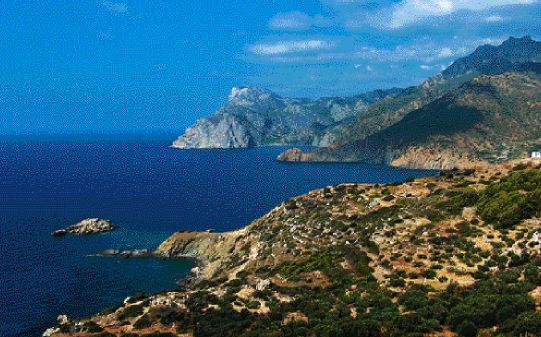 View over the eastern coast |
|
| lies in the north. Since this is the second-largest island in the Dodecanese (49 kms long), the north is more than a bus stop away. In fact, the bus from Pigadhia does not even go there. A long section of the road north is unpaved and said by those in the car hire trade to be negotiable only by 4-wheel drive vehicles, though this may be a profitable exaggeration. The point is that you will conclude the most pleasant, and the simplest, way to get from Pigadhia to Olympos must be by boat. That's why you're on the quay, preparing to weigh up your options. But you quickly discover that there is nothing to weigh. Just one excursion boat goes from Pigadhia to Olympos and its owner, a woman who always seems to wear (Olympos) black, is more than ready to welcome you - and everyone else - aboard. From 8.00am the coaches pull up. Holiday reps guide their charges up the gangplank. Whatever deal the lady in black has done with the tour companies has doubtless been fixed long ago. But not so with people like you. You need a return ticket. "How much is it? " She knows you have no choice so she is already scribbling out a voucher with, on this occasion, 20 euros at the bottom of it. That's sounds steep, you think. And it's surprising that there are no pre-printed tickets with prices on them. But if you want to get to Olympos, what can you do? At 8.30 am the Chrysovalantou sets out with about 150 people aboard. You can hear the cash tills applauding. |
||
|
It is a scenic journey. At first, there are clouds romping about on top of clifftops in a blue sky but the further north you get the more subdued the light becomes. The craggy Karpathian coastline bucks about in front of you. Hanging onto it are little white settlements, dark swathes of pine trees and isolated churches. Sometimes the road you did not take materialises for a moment before being thrown off again. By the time you reach Diafani - the small port connected by tarmac with Olympos - it is raining. Diafani looks pleasantly deserted. The reason is not the weather. It is the fact that two buses are awaiting the arrival of the boat, ready to take all the passengers straight up to Olympos. Everyone knows the routine. |
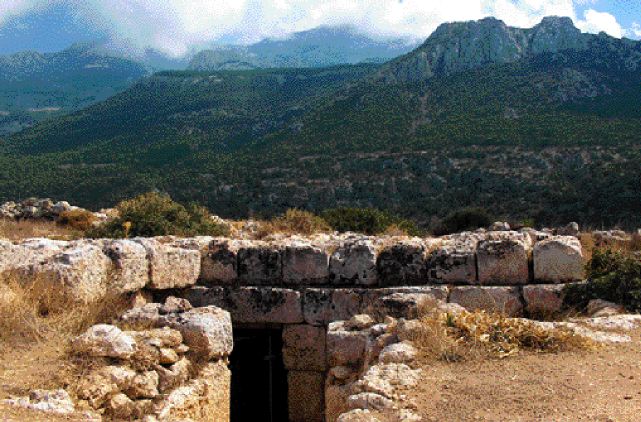 Roman cistern near Lefkos |
|
| Diafani will get its chance later in the day. On to Olympos, the road's traverses make it look further away than it really is but even so, after about fifteen minutes, the village comes into view across the valley. The impact of the first sighting is unfortunately dulled on this occasion by the weather but a photo stop is included in the package you now seem to be part of, so in spite of a rain shower that is what you get. Olympos was always meant to be hard to get to. Built by the inhabitants of coastal Vrykounda (originally one of four key Dorian settlements on the island) between the 7th and 9th centuries, it was intended to provide a safe haven from pirates. Hidden away on a ridge beneath Mt Profitis Ilias (718m high), it no doubt worked. Its remoteness is responsible for the fact that so many village customs were maintained for so long - in terms of dress, handicrafts and social organisation (it is a matriarchy). Its inhabitants are even said to speak with a dialect all their own which has traces of Phrygian and Dorian origins. But most old habits that persist today, like the communal baking of bread in a wood-fired oven, do so primarily because of their viewing value. The weather has improved but getting off the tour bus and walking into Olympos this morning is not a pleasant experience. The women are waiting. In black, in white, with colourful aprons and wearing obligatory headscarves, they are ready to give you a traditional welcome. They know that the bus driver has just told you the timetable. You have three hours here. That is going to leave you with two hours to spend in Diafani before the boat leaves. In other words, your time and expenditure has been divvied up for you. Everyone wins. |
||
|
As I walk along the main street into town I find myself unusually irritated. In fact, I wish I wasn't here. I have no interest in taking part in this bazaar. "Welcome to Olympos. You come buy in my shop...You want to take picture? " After a bit, I find refuge in a little cafe called Zephyros with stunning views down to the sea. Some old windmills, village trademarks, are visible on the hillside. Opposite is Olympos' main church, the colourful 16th century Dormition of the Virgin with its four-tier bell-tower. Georgia, who brings me coffee, sees me watching some of my fellow tourists outside. When I tell her I am planning to stay overnight, she nods. "This is not the right way to have a holiday," she says, pointing outside. "They get here, you see them rushing round taking photographs, checking their watches, always in a hurry..." She pauses, puzzled. "They can't really enjoy it, can they?" |
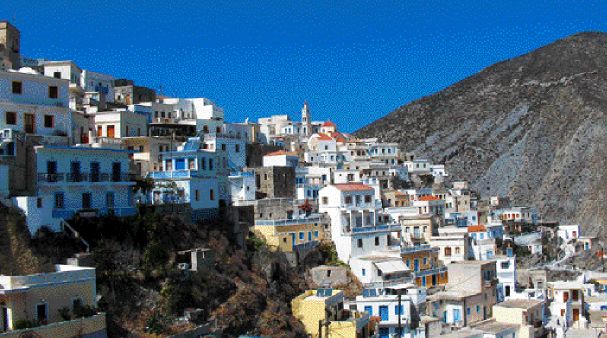 Olympos |
|
|
I am implicated, of course, just by being here. But the astonishing thing is what happens to Olympos once the bus leaves. Because the frenzy is now over, you can walk the streets without being urged to buy anything. People are relaxed and friendly. The village breathes again and though it does not alter the parameters of the transactions in which you are involved it takes the edge off them. And it feels good to have changed from a three-hour blur into something approaching a visitor. And Olympos really is special. All vehicles stop below the village so there is a wonderful stillness in the air. And at night, it is absolute. There are alleys to explore and views to find and places to sit and contemplate, and the patterns made by the buildings over the ridge on which they sit are as charming as the individual houses themselves, but for me it is the height and silence and the sense of being hidden away from the rest of the world that resonate most strongly. Olympos also makes a good base, if you like walking. There are opportunities to go either to the ancient site of Vrykounda with its surviving Hellenistic walls, its ancient tombs and a chapel of St John hidden away in a cave or, further away still, to the enclosed bay of Tristomo where a few houses stand right on the waterside. On the way, you will go through a fertile valley where the mostly deserted village of Avlona still stands. These were the summer houses for the people of Olympos and Diafani when they wanted to be close to their fields at harvest time. |
||
'Safe' villages The pirate problem which prompted the founding of Olympos was not limited to the north of the island. Fortunately, Karpathos is rich in mountains (and therefore sites for other 'safe' villages), a fact which must have been behind the myths that Titans and Giants once made their homes here. In terms of humans, after a neolithic start, the island's overlords can be traced from the Minoans to the Myceneans to the Phoenicians to the Dorians, who arrived in about 1000BC. There are remains of two Dorian settlements - those walls at Vrykounda and an acropolis at Arkassa in the south-west. |
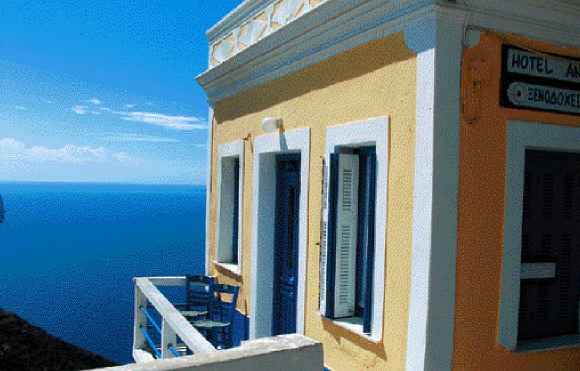 The hotel "Anemos" in Olympos |
|
In general, though, past rulers of Karpathos have not left much behind. There is little to show for the Genoese (1204-1306) and Venetian presence (1306 -1537) and even the Turks, in their 400-odd year rule of Greece, mostly left the island alone. This may have been partly to do with its location, comparatively isolated from the rest of the Dodecanese, but it was probably also because of its reputation as a pirate stronghold. The Italians' relative lack of interest (from 1912-1932) was for different reasons; they were more focused on Rhodes. Aperi, one of the 'safe' villages in the mountains near Pigadhia, is said to be the richest in Greece, though I'm not sure whose league table that is. In addition to Aperi, there are other attractive well-kept villages with huge views - Volada, Othos, Pyles and, further south, Menetes. They are, mostly, prosperous on the repatriated US dollar which is why they are to be seen, not stayed in. They do not need tourists. But my other favourite village, besides Olympos, is not high up and it does not need visitors either, but for different reasons. In fact, Mesohori seems to be slipping right off the edge of the mountain into the sea. A road that skirts the western edge of central Karpathos takes you there through what is now, sadly, a former pine forest - it was burnt mostly to the ground in fires about 20 years ago. But it is still a dramatic ride. There are plenty of coves and sandy beaches on one side of the road (including the bright turquoise curve of Lefkos bay) and sheer mountain walls on the other. Mesohori waits at the end, a pretty cluster of whitewashed houses that seem to be dripping in greenery. At Olympos, cars stopped at the bottom of the village; in Mesohori they stop at the top. And what a trip it is down steps and alleys through the white-washed village, delightfully free of all tourist paraphernalia. The village has a fine water supply, and it makes full use of it. In fact, you could believe you've happened on the finals of an agricultural show. Branches heavy with figs, lemons, limes, oranges, pomegranates and grapes are leaning over walls; vegetables - cauliflowers, cabbages, tomatoes - have invaded the little house plots; geraniums, basil and peppers crowd pots sitting outside front doors. Bougainvilleas have taken over the paths. And as if all this isn't enough, there are allotments with more of the same at the village edge. In one of them, a banana tree waves its big leaves. There is no single route through the village but, if you keep following the fall lines, you will eventually reach the plateia, right at the bottom overlooking the sea. Three small churches and a monument to the war dead stand there. It is a large area and the blue railings that surround it have been painted recently. This is a village that is rightly proud of itself. Back at the top, I have something to eat at a small cafe. The old lady technically needs to bring me 40 cents change, which I will leave as a tip in any case. It takes a long time but when the change comes I understand why. She had no 20 cent coins, no 10 cent coins, not even any 5 cent coins. It is made up entirely of 1 cent and 2 cent coins. I leave them when I go. But she comes after me. And before I can get away, she has pressed a single fifty cent coin into my hand. |
||
Regulation? This is all a far cry from that woman in black on the Chrysovalantou. I don't really want to spoil the atmosphere by going back to her operation. But on an island with so much that is good about it, what she is up to with her Pigadhia-Olympos boat and bus service really rankles. Anyone who has spent time travelling round the Greek islands gets a good feel for what is a fair price and what isn't. Locals in Pigadhia tell this story. Last year, as for many years past, there were two boats (ironically owned by related Olympos families) offering the excursion and they competed for custom. The price in high season last year was, apparently, 15 euros. This year, though, the Chrysovalantou has a monopoly. Prices in high season went up to a heady 25 euros. And off high season? It depends on whom you talk to. Some people say it should be 12 euros, some say 15 or 16... If you get lucky and catch one of the mainline ferries that call in at Diafani a single trip will cost you just 3.50 euros. |
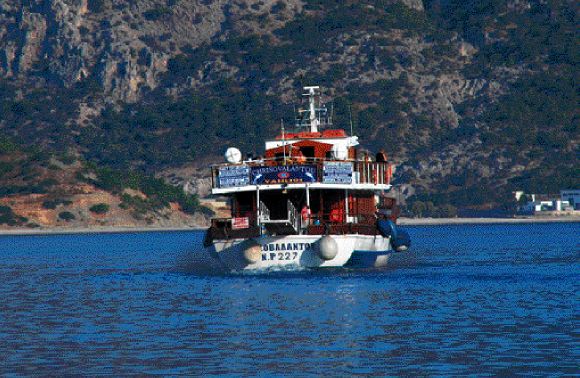 Chrysovalantou boat, which travels the length of the island, still without an asphalt road |
|
| The Chrysovalantou system is that you return your hand-written voucher when you get back on the boat at Diafani so all records are held by them. Say no more. This is exactly the kind of tourist operation that gives Greece a bad name. |
||
|
How to get there Where to stay Where to eat |
||
|
|
||
(Posting Date 7 September 2006 ) HCS readers can view other excellent articles by this writer in the News & Issues and other sections of our extensive, permanent archives at the URL http://www.helleniccomserve.com./contents.html
All articles of Athens News appearing on HCS have been reprinted with permission. |
||
|
||
|
2000 © Hellenic Communication Service, L.L.C. All Rights Reserved. http://www.HellenicComServe.com |
||

